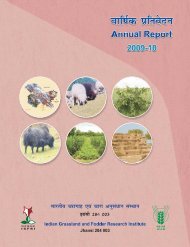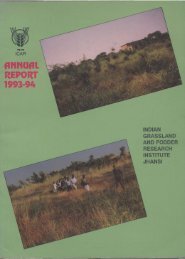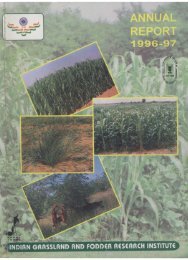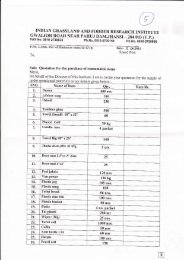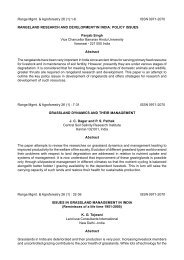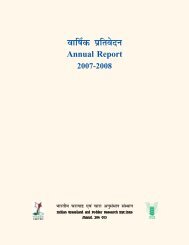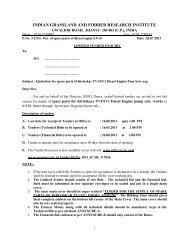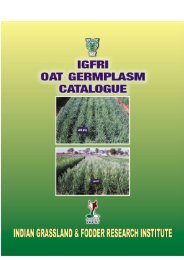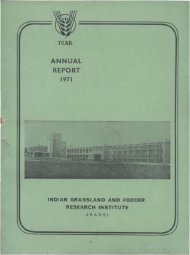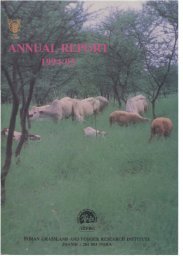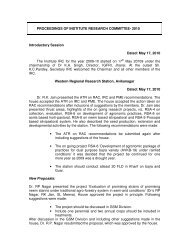Forage Production Technology for Arable Lands - Indian Grassland ...
Forage Production Technology for Arable Lands - Indian Grassland ...
Forage Production Technology for Arable Lands - Indian Grassland ...
Create successful ePaper yourself
Turn your PDF publications into a flip-book with our unique Google optimized e-Paper software.
system in these problematic soils gives 25% higher net return over rice-wheat croppingsystem. Application of pyrites 2-4 t/ha increases berseem yield by 16-26 per cent.Application of pyrite/gypsum (5.0 t/ha) depending upon the gypsum requirement of thesoil in different crops like sorghum, pearl millet and perennial grasses gives 2-4 foldincrease in the <strong>for</strong>age productivity. Integration of the reclamation approaches withproper nutrient management further increase the productivity of these crops by 15-21 percent.Specific benefits : Increased availability of herbage <strong>for</strong> sustained livelihood from nonproductive land, efficient utilization of natural resource and gradual reclamation of thesoil due to improvement in physico-chemical properties of soil and regular employmentgeneration opportunity to the farmers.Constraints in adoption: Availability of the good quality water <strong>for</strong> reclamation of thesesoils is major constraint. Initial cost of amendments, irrigation facility and installation ofdrainage in currently non productive land restricts the adoption of this technology.Scope <strong>for</strong> commercialisation: In India, several programmes are running <strong>for</strong>reclamation of saline and sodic soils. <strong>Forage</strong> based cropping system can be integratedwith these programmes to promote the <strong>for</strong>age production and conservation/improvement of natural resources.4.2. <strong>Forage</strong> production in acid soilsThe crop production in acid soils (below pH 5.5) are impaired due to excess activity ofAl, Mn and Fe and deficiency of P, Ca, Mg and Mo. Low soil biological activity affectnutrient cycling in these soils. Other constraints in these soils are low base status, lowCEC and poor soil fertility. <strong>Technology</strong> developed <strong>for</strong> amelioration of acid soil <strong>for</strong>fodder production needs to be undertaken by sensitizing the stake holders. Grasses arefound to be more tolerant than annual crops, like legumes and cereals. In slightly tostrongly acid soils (pH 5.5 - 6.0) maize, Deenanath grass, napier bajra hybrid, guineagrass and Setaria grass per<strong>for</strong>ms better than other fodder crops.Adaptation area: Acid soils occupyabout 100 m ha in India; out of this 49m ha are under crop cultivation. Acidsoils occur mostly in North-EasternStates, Kerala, Himachal Pradesh,Orissa, Jammu & Kashmir,Karnataka, Jharkhand and northBengal. These soils are under rainfed34 <strong>Forage</strong> <strong>Production</strong> <strong>Technology</strong> <strong>for</strong> <strong>Arable</strong> <strong>Lands</strong>



